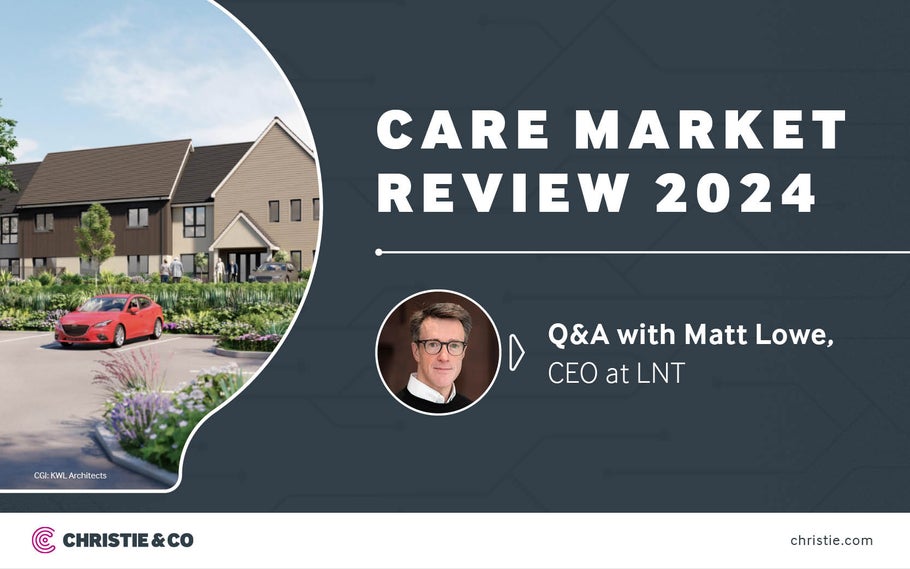Care Market Review 2024: Q&A with Matt Lowe, CEO at LNT
In this Q&A blog post, as part of our Care Market Review 2024, we spoke with Matt Lowe, Chief Executive Officer at LNT about his views on the care sector in 2024.
Business. Built around You.
Your expert business property advisers

Q: What is the impact of the new technology on operating efficiencies?
Matt: New technology in our latest generation of care homes is multi-faceted across ESG and in-home design. The benefit of ESG design is easy to understand - the increased use of self-generated energy reduces utility bills for operators of course. Standardisation and monitoring across our homes help this further by identifying any system problems early. The in-home technology is more difficult to financially quantify, but we focus on using technology to directly improve resident and colleague experience (comfort cooling, improved lighting systems, usable high-speed Wi-Fi etc.), and also the less obvious indirect areas that fall off the back of the infrastructure e.g. digital support to our teams, improved call bell systems, and other preventative systems that rely on handheld devices and stable Wi-Fi. Our thinking is that any time savings we create through the use of technology should be reinvested in more personalised quality care for our resident families.
Q: Can you outline how your care home design has evolved over the last two years, particularly from an ESG/environmental efficiency and net zero perspective?
Matt: We’ve been building environmentally aware homes for some time now, having started with the use of heat pump technology almost 10 years ago. Solar and battery technology then followed; an area that we are constantly evolving as technology improves and becomes more affordable, further embedding the technology into the design. We’re so confident with this technology that we have now removed gas from our buildings altogether. We don’t yet think we’ve maximised self-generation, but our team spend as much time now considering how to reduce usage across our homes.
Q: Have build costs materially increased with the new technologies that you are installing alongside the recent inflationary pressures?
Matt: Cost inflation has impacted everyone over recent years, albeit that same inflation has increased operator fees, in turn having an upward impact on rents ensuring both operations and development remain sustainable. We have seen inflationary increases in construction costs fall away more recently, with some areas even moving into reverse where supply has caught up with demand. I think the investment costs of installing ESG technology are important for the operator if the building is to be fit for purpose throughout its life. You could note that like-for-like ESG technology has become more affordable over the years as the industry has become more established and producers have scaled up to meet demand, however, we want to stay at the cutting edge of what’s possible, so we will keep pushing. We think it’s the right thing to do, the team enjoy the engineering challenges it brings, and it will benefit operators and residents for many years to come.
Q: How do you think care home design and technologies will evolve over the next five years and what will a new build home in 2030 look like?
Matt: I’d love to have a crystal ball! The technology providers will constantly evolve and find more and more efficiencies which we will try to incorporate where it makes provable sense to do so. Thinking more broadly, AI or Gen Tech are easy things to point toward in terms of the next steps in technology and design, but I do believe we are only scratching the surface of how this will be able to help throughout the life cycle of a home, and for those living and working within it. The predictive ability of machine learning and Gen Tech allied to healthcare and energy technology could create some very exciting opportunities to save time, improve quality and make further efficiency gains across the industry. I don’t yet see any different models emerging that can use technology to substitute human companionship, rather that technology will enable increased human-to-human connections to be formed.
Q: Where do you see the opportunities for growth in the market?
Matt: The Office for National Statistics (ONS) shows the data relating to different age ranges across the UK. The ageing population has been a discussion point in the industry for some time, but the statistics very clearly show that the growth in older citizens is shortly to be upon us and that the supply side of our industry is not producing nearly enough to meet this demand. This swell of an ageing population, who have a higher likelihood of requiring care support, also arrives with much higher expectations of quality and service than those that have come before. Our team have built a very strong land pipeline and we’re ready to build it to meet this future demand. I think this demographic opportunity allied with the changes in technology suggests exciting times ahead.
Matt Lowe is the Chief Executive Officer at LNT, one of the UK’s leading scale suppliers of care homes operating on a carbon-zero basis. He has led the business since 2015, having joined the group in 2012 as Commercial Director, and is now one of the UK’s most highly regarded industry experts. Matt has outstanding market knowledge from working at an operational level and at board level across the entire ecosystem of Operators, Developers and Funders, and has a unique ability to apply his knowledge right across the sector, working tirelessly to grow LNT to its market-leading position today.
To learn more about the care market in 2024, click here to read our Care Market Review 2024.